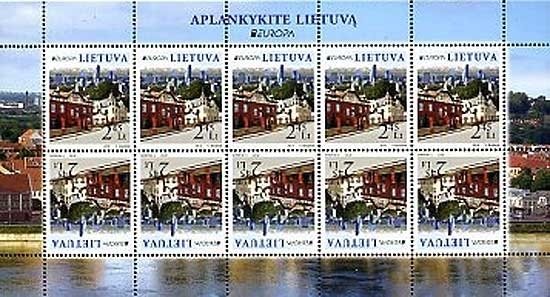Mini Sheet: Lithuanian architecture (Lithuania 2012)
Lithuanian architecture (Lithuania 2012)
28 April (Lithuania ) within release Europa 2012. Visit. goes into circulation Mini Sheet Lithuanian architecture face value 10*2.45 Lithuanian litas
| Mini Sheet Lithuanian architecture in catalogues | |
|---|---|
| Michel: | Mi:LT 1104 Klb |
Mini Sheet is square format.
Artist V.BrucieneAlso in the issue Europa 2012. Visit.:
- Stamp - Lithuanian landscape face value 2.45;
- First Day Cover - Europa 2012. Visit. face value 10*2.45;
- Mini Sheet - Lithuanian landscape face value 10*2.45;
- Se-tenant - Lithuanian landscape face value 2*2.45;
- First Day Cover - Europa 2012. Visit. face value 10*2.45;
- Souvenir Sheet - Europa 2012. Visit. face value ;
- Stamp - Lithuanian architecture face value 2.45;
- First Day Cover - Europa 2012. Visit. face value 2*2.45;
- Mini Sheet - Lithuanian architecture face value 10*2.45;
- Se-tenant - Lithuanian architecture face value 2*2.45;
Mini Sheet Lithuanian architecture it reflects the thematic directions:
The European Conference of Postal and Telecommunications Administrations (CEPT) was established on June 26, 1959, as a coordinating body for European state telecommunications and postal organizations. The acronym comes from the French version of its name Conférence européenne des administrations des postes et des télécommunications.
The Europa postage stamp (also known as Europa - CEPT until 1992) is an annual joint issue of stamps with a common design or theme by postal administrations of member countries of the European Communities (1956-1959), the European Conference of Postal and Telecommunications Administrations (CEPT) from 1960 to 1992, and the PostEurop Association since 1993. Europe is the central theme. EUROPA stamps underlines cooperation in the posts domain, taking into account promotion of philately. They also build awareness of the common roots, culture and history of Europe and its common goals. As such, EUROPA stamp issues are among the most collected and most popular stamps in the world. Since the first issue in 1956, EUROPA stamps have been a tangible symbol of Europe’s desire for closer integration and cooperation.
Architecture (Latin architectura, from the Greek ἀρχιτέκτων arkhitekton "architect", from ἀρχι- "chief" and τέκτων "builder") is both the process and the product of planning, designing, and constructing buildings and other physical structures. Architectural works, in the material form of buildings, are often perceived as cultural symbols and as works of art. Historical civilizations are often identified with their surviving architectural achievements.



